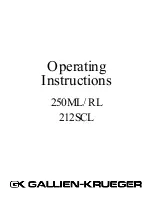
Page 29
Macro-Tech 5000VZ Power Amplifier
Reference Manual
sipate. Also, the lower
the resistance of the
power transistors, the
more voltage you can
deliver to the load. But at
the same time that you
lower the resistance of
the transistors, you in-
crease the current pass-
ing through them, and
again increase the
amount of heat they
must dissipate.
5.2.2 The VZ Supply
An articulated power supply like Crown’s VZ design
can circumvent much of this problem by reducing the
voltage applied to the transistors when less voltage is
required. Reducing the voltage reduces the heat which
makes the amplifier runs cooler. This makes it possible
to safely pack more power into the chassis.
The VZ supply is divided into segments to better match
the voltage and current requirements of the power tran-
sistors. Remember that audio signals like music are
complex waveforms.
The power transis-
tors stay cooler and
are not forced to
needlessly dissipate
heat. This is the nor-
mal operating mode
of the VZ power sup-
ply.
When the voltage re-
quirements are high,
a VZ supply switches
into to a
high-voltage
mode to produce
higher voltage and less current. The amplified output
signal never misses a beat and gets full voltage when it
needs it—not when it doesn’t need it.
Sensing circuitry monitors the voltage and current de-
mands of the signal and load to determine when to
switch VZ modes. The switching circuitry controls the
power supplies (not the output devices) which yields
the highest dynamic transfer function with no audible
switching distortion—you hear only the music, not the
amplifier. The VZ design gives you maximum power,
maximum safety, and power optimized for your load.
5.3 Circuit Theory
Each channel is powered by its own transformer, T100
or T200. The secondary of T100 is full wave rectified by
DB100 and DB101 and filtered by large computer
grade capacitors (C810 and C812 for Channel 1). The
transformers are protected against catastrophic failure
by fuses F700 and F701 and thermally protected by
internal self-resetting switches.
Both channels share T1, a low-voltage transformer. The
output of T1 is rectified by diodes D709 through D714
providing an unregulated 24 volts. Monolithic regula-
tors U715 and U716 provide the regulated ±15 volts.
T1 is protected by fuse F702.
5.3.1 Stereo Operation
For simplicity, the discussion of stereo operation will
refer to one channel only. Mono operation will be dis-
cussed later.
Please refer to the block diagram in Figure 5.5 and the
schematics provided at the back of this manual.
The input signal at the XLR and phone jack input con-
nectors passes directly into the balanced input stage
(U100A). When the compressor is enabled, the com-
pressor control circuit (U101, U102 and U103) causes
POWER
TRANSISTOR
POWER
TRANSISTOR
SPEAKER
LOAD
POWER
SUPPLY
+
–
Fig. 5.1 A Typical
Power Supply
POWER
TRANSISTOR
POWER
TRANSISTOR
SPEAKER
LOAD
VZ
STAGE
+
–
VZ
STAGE
+
–
VZ POWER SUPPLY
Fig. 5.4 VZ High-Voltage Mode
POWER
TRANSISTOR
POWER
TRANSISTOR
SPEAKER
LOAD
VZ
STAGE
+
–
VZ
STAGE
+
–
VZ POWER SUPPLY
Fig. 5.3 VZ High-Current Mode
Fig. 5.2 Music Waveforms
For music the average level is always much less than
the peak level. This means a power supply does not
need to produce full voltage all the time.
The VZ supply is
divided into two
parts. When the
voltage require-
ments are not
high, it operates
in
high-current
mode to produce
less voltage and
more current.
















































